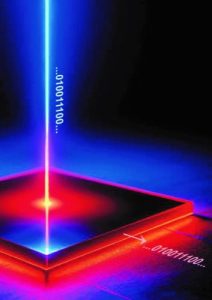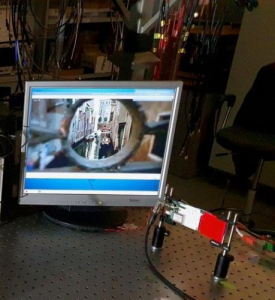Light Communication: Towards a New Generation of Wireless Optical Networks
 The National Research Council of Italy (CNR), in collaboration with the Scuola Superiore Sant’Anna, the LENS Laboratory, and the Universities of Florence and Pisa, has developed an innovative wireless communication system based on visible light communication (VLC). The system leverages commercial white LEDs and luminescent solar concentrators (LSCs). The results, published in Scientific Reports and Advanced Optical Materials, open new possibilities for secure, efficient, and low-cost communication technologies. In this application, LSC devices function as antennas to receive data transmitted by LEDs or lasers (Li-Fi) and relay it to a receiver. Tests conducted at the laboratories of Scuola Superiore Sant’Anna in collaboration with CNR-INO demonstrated the ability to transmit data at over 70 Mbit/s without requiring precise alignment between transmitter and receiver. LSC concentrators offer high sensitivity, a wide field of view, and stable performance in indoor environments, enabling HD video streaming and internet access in museums, schools, hospitals, offices, and shops. The project involved the development of three different types of LSCs. The materials used for their fabrication were developed by CNR-ICCOM (Leaf Lab, http://www.iccom.cnr.it/it/leaf-lab/) in collaboration with Professor Andrea Pucci’s group from the Department of Chemistry at the University of Pisa.
The National Research Council of Italy (CNR), in collaboration with the Scuola Superiore Sant’Anna, the LENS Laboratory, and the Universities of Florence and Pisa, has developed an innovative wireless communication system based on visible light communication (VLC). The system leverages commercial white LEDs and luminescent solar concentrators (LSCs). The results, published in Scientific Reports and Advanced Optical Materials, open new possibilities for secure, efficient, and low-cost communication technologies. In this application, LSC devices function as antennas to receive data transmitted by LEDs or lasers (Li-Fi) and relay it to a receiver. Tests conducted at the laboratories of Scuola Superiore Sant’Anna in collaboration with CNR-INO demonstrated the ability to transmit data at over 70 Mbit/s without requiring precise alignment between transmitter and receiver. LSC concentrators offer high sensitivity, a wide field of view, and stable performance in indoor environments, enabling HD video streaming and internet access in museums, schools, hospitals, offices, and shops. The project involved the development of three different types of LSCs. The materials used for their fabrication were developed by CNR-ICCOM (Leaf Lab, http://www.iccom.cnr.it/it/leaf-lab/) in collaboration with Professor Andrea Pucci’s group from the Department of Chemistry at the University of Pisa. The research was funded by the PNRR projects “RESTART” and “I-PHOQS,” and supported internally by CNR through the FLUOCOM project (Ricerca@CNR).
The research was funded by the PNRR projects “RESTART” and “I-PHOQS,” and supported internally by CNR through the FLUOCOM project (Ricerca@CNR).
